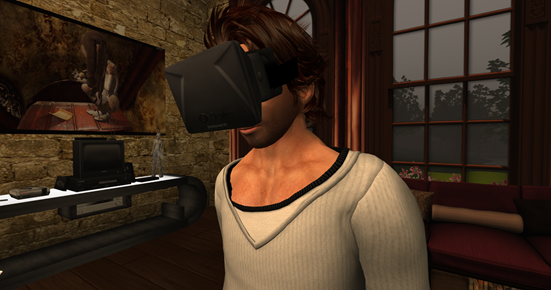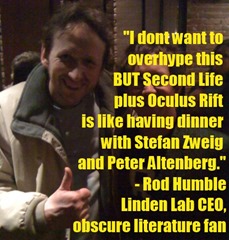The Oculus Rift and #SecondLife Hype
In a recent conversation with Mona Eberhardt, a number of topics came up about Oculus Rift and how it’ll do wonders for Second Life. Not that either of us believe that, but if you were to read Hamlet’s blog you would think otherwise. It would seem as though it is a foregone conclusion that Oculus Rift will be mass adopted and usher in a new golden age of virtual reality, but I am not so taken in by the hype.
After all, this would only be an accurate statement if Oculus Rift invented the first virtual reality headset, and it would be true if there weren’t any other long standing companies that offered virtual reality and augmented reality headsets. It’s not like Occulus is cornering the market or anything, and as a matter of course, it’s simply a new Head Mounted Display unit.
What makes this so special, then?
Well, the consensus is that it has higher tracking fidelity and also 1080p resolution. For what it is worth, I agree those are definitely advancements in the industry, but not for lack of being able to do it otherwise. There really isn’t much of an advancement here to speak of, other than ones that are inherent with technology already. The components got smaller, lighter and cheaper – but it’s not like Occulus innovated those advancements. Just like you can, they built something with off the shelf components and then raised a bunch of venture capital to up it to 1080p.
The hype of it all is a requirement, though. That is what happens when you’re sitting on $16 million USD in venture capital and need to make one hell of an ROI.
Yes, this HMD is impressive – that much I am conceding to (and always have). What I do not believe is that it will have mass adoption past a certain niche audience. Oculus Rift poses an interesting paradox in much the same way as NEO-GEO did in the 1990’s. NEO-GEO’s claim to fame was that it offered a home system that played arcade perfect versions of their games. This, as a result, made it absolutely superior to every home console at the time, and yet NEO-GEO did not dominate the market, even when they had a killer application.
The first issue was price, and truth be told the NEO-GEO was very expensive, as were the games. This was due to the fact that NEO-GEO as a home console wasn’t just porting or emulating those arcade games, it really was the same system as the board in the arcade cabinets. The cartridges for the games were essentially repackaged MVS cartridges that were used in the arcade cabinets themselves.
Had the price point been brought down to the median for home consoles during that time, there is a really good chance that you’d never know what Nintendo, XBox or Playstation were today.
In relation to Oculus Rift, they don’t exactly have a price-point problem. $300.00 USD for the Developer Kit is reasonable. What they have a problem with is that (like the NEO-GEO) they carry a pre-disposed stigma which they aren’t going to shake.
Without a “killer application”, Oculus is relegated to “early adopter” rich-kid toy. Second Life isn’t a killer application for Oculus any more than literally anything off the shelf at Vuzix or the original VFX Headsets (if they hadn’t essentially went under from the last VR hype collapse). The people who will actually use it for Second Life are that same niche Richie Rich demographic which is inclusive to some content creators. This is to say, the demographic for Second Life adoption is the same demographic that thinks nothing of dropping $300.00 USD for a technology toy they will not use outside of a niche experience. In relation to Second Life, a large portion of the user experience is not inclusive when you are wearing the Oculus Rift, and so for a majority of interaction and daily use (read: most of the time) your amazing HMD will sit on the desk next to your NEO-GEO.
Oculus won’t be the “de-facto” method to experience SL, but it will be one of those “something to experience at least once” before the novelty wears off sort of things.
We all had that one friend who had the high-end toys, and most of us never had those toys ourselves but that didn’t stop us from going over to that one friend’s house to play NEO-GEO, Sega CD or Atari Jaguar. We all knew that friend had a full Laser Tag set in the closet and a Teddy Ruxpin as well.
What Oculus Rift represents is that sort of mentality.
Yeah it’s really cool, and it’s probably really damned impressive. But even if they managed to give it away for free, everyone would have one and just as many in a niche would actually use it regularly while the rest of us would stick it in the closet with Teddy Ruxpin and our NEO-GEO.
What makes Oculus Rift amazing is also what
makes it a niche use for Second Life.
At the end of the day, Oculus takes into account maybe 10% of the interaction paradigm that is Second Life and just caters to that little slice while doing nothing for the other 90% of the dynamics involved.
It doesn’t have a built-in microphone, nor does it have speakers/headphones. The interaction paradigm is essentially cut off from the get-go because unless you are a touch typer, you are out of luck trying to chat in local, or respond to private IMs, or use group chat. Building with an Oculus Rift would be a nightmare scenario. Using the interface in SL may as well be a no-go just as well.
So, what the hell is Oculus Rift good for in Second Life?
It’s good for presentation in first person view. That is what remains when you take away the other 90% of the Second Life dynamic. Tourism and sightseeing as an all but mute participant.
That alone is an overwhelming feeling of isolation when you think about it.
Add in an additional mic headset and you might get to talk. Though there really isn’t much of a hands-free option other than push to talk (once again back to the mouse you can’t see) or leaving your mic wide open all the time.
The Oculus Rift represents a consumer of media (push media) mentality versus the asynchronous interaction (social prosumer) that Second Life actually is. This is to say that it caters to an immersive mentality that is natively contradictory to the paradigm of interaction that is Second Life.
Then there is some aspects of the technology which absolutely baffle me…
If this HMD was meant for gamers, and it’s well known that it heavily caters to FPS games, then they should already have understood the obvious design flaws in their product through actually doing 30 seconds of due diligence finding out how the average gamer plays their games.
Online, multiplayer, with a headset microphone and headphones.
With that list of criteria, Linden Lab and Oculus should know better than to hype the Rift the way they are doing without addressing the following:
1. Communication.
2. Interaction Paradigm in a real world use case setting
3. Actually building a product that incorporates multiple modes of sensory inclusion
Gamers want to chat, talk, hear the environment and feel immersed without breaking the metaphor of immersion. Oculus does wonders for making it look pretty and in first person but if we were to give it a report card it would be failing every other class.
It’s pretty much like getting an A+ in Art Class and an F in Social Studies, Math, and Language.
Now, the other issue I’m seeing here has less to do specifically with Oculus Rift and more with Linden Lab riding the coattails of hype in order to pull the “cool by comparison” PR trick.
When Rod Humble makes the statement on the left (from nwn), you have to understand this is coming from the company that literally exists from feeding on a massive amount of hype, is the king of overpromising and under delivering, and has absolutely everything to gain from riding the coattails of Oculus Rift in the media in order to reboot their bad reputation.
This is akin to a celebrity that was the darling of the media going on an all-out bender and falling from the graces of mainstream media and public opinion, coming out of rehab and hanging out with Johnny Depp during the launch of Pirates of the Caribbean in hopes that hanging out with the cool kids will turn public opinion again and they will re-launch their career.
I suppose, in short, Linden Lab is hoping to be Robert Downey Jr, except that the difference being that Robert Downey Jr actually cleaned up his act, reinvented himself and didn’t dick around by trying to pretend he was a musician instead of an actor.
Which, unfortunately is the analogy for Linden Lab since they haven’t gotten out of rehab yet, are attempting to be a video game company, and in that denial and attention whore fashion are hanging out with Oculus and saying “Remember us? We’re cool again just like this Oculus thing!” – which bring up memories of Dr. Evil trying to prove he’s “hip”.
Here’s how it works in reality:
If Nintendo can’t convince you that a VR device, initially designed by Jaron Lanier, is the perfect fit for gaming and re-ignite Virtual Reality, then nothing short of a miracle is going to change that situation for Oculus Rift. Linden Lab is two-bits compared to Nintendo and Oculus sure as hell wasn’t designed by the guy who popularized the term Virtual Reality.
Oculus Rift is to Second Life what the Power Glove was to Nintendo.
Of course, all Linden Lab would have to do is design an amazing interface for the Oculus Rift which takes care of the massive oversight that is 90% of the interaction dynamic and -
C’mon, who the hell are we kidding?
Seriously… this is the company responsible for Viewer 2 and the only reason the TPVs follow suit with their Viewer 3 designs is because instead of actually designing a better viewer Linden Lab just decided to change the rules of the game and force everyone else to follow them through “shared experience”.
Enjoy your Power Glove, kids.













0 Comments:
Post a Comment